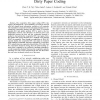Free Online Productivity Tools
i2Speak
i2Symbol
i2OCR
iTex2Img
iWeb2Print
iWeb2Shot
i2Type
iPdf2Split
iPdf2Merge
i2Bopomofo
i2Arabic
i2Style
i2Image
i2PDF
iLatex2Rtf
Sci2ools
ICC
2008
IEEE
2008
IEEE
Power and Bandwidth Allocation in Cooperative Dirty Paper Coding
—The cooperative dirty paper coding (DPC) rate region is investigated in a two-transmitter two-receiver network with full channel state information available at all terminals. The transmitters cooperate by first exchanging messages over an orthogonal cooperation channel, then they mimic a broadcast channel (BC) and jointly perform DPC to send to the two independent receivers. The allocation of network power and bandwidth between the data and the cooperation channel is studied to characterize the cooperative DPC rate region. First, the optimal sum power allocation for a multiple access channel (MAC) is presented. Then through an application of MAC-BC capacity duality, the cooperative DPC rate region is evaluated under different bandwidth allocation assumptions. Cooperative DPC outperforms non-cooperative time-division (TD) only when the cooperation channel is strong, since the joint-encoding capacity gain is negated by the overhead of message exchanges in a weak cooperation channel. ...
Related Content
| Added | 30 May 2010 |
| Updated | 30 May 2010 |
| Type | Conference |
| Year | 2008 |
| Where | ICC |
| Authors | Chris T. K. Ng, Nihar Jindal, Andrea J. Goldsmith, Urbashi Mitra |
Comments (0)

